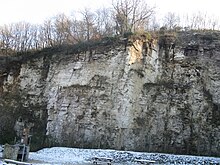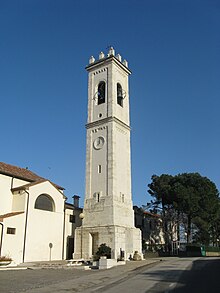Rovolon
| Rovolon | ||
|---|---|---|

|
|
|
| Country | Italy | |
| region | Veneto | |
| province | Padua (PD) | |
| Coordinates | 45 ° 22 ′ N , 11 ° 40 ′ E | |
| height | 18 m slm | |
| surface | 27.56 km² | |
| Residents | 4,911 (Dec 31, 2019) | |
| Population density | 178 inhabitants / km² | |
| prefix | 049 | |
| ISTAT number | 028071 | |
| Website | Rovolon | |
Rovolon is an Italian commune with 4911 inhabitants (as of December 31, 2019) in the province of Padua in the Veneto region .
geography
The municipality extends on the northwest side of the Euganean Hills along the border with the province of Vicenza . It lies partly in the hills and partly north and northeast in the plain.
The eponymous core town of Rovolon is located on the north side of Monte della Madonna ; this mountain with its Benedictine sanctuary and a wide view of the Po Valley is one of the main attractions of the Euganean Hills Natural Park ; the Santuario and the winding, narrow driveway from the south side do not belong to Rovolon, but to the municipality of Teolo .
On the western flank on the hillside is the district of Carbonara, named after the charcoal that was extracted in the forests in the past.
To the north of the plain lies the district of Bastia, which was a central traffic junction and where the municipal administration is still located today.
history
The oldest established historical testimony is a donation of the territory of Rebolone (presumably a Longobard name) by the Bishop of Padua, Gauslino Transalgardo , to the Benedictine monks of Santa Giustina , an abbey built over the bones of the local saint Justina of Padua , which flourished in the 17th century . Century experienced.
At the time of the donation, the land was still called "terreno duro" (hard land) because it was considered impossible to cultivate due to the harsh climate; Nevertheless, on behalf of the Benedictines, the farmers managed to cultivate 700 fields over the centuries, which has been managed centrally by the Vegrolongo estate since 1441 .
To the north of the plain, massive fortifications were built by the Padans in the 13th century to defend the territory against Vicenza . Even after these were destroyed by the Scaligians at the beginning of the 14th century , the name "Bastia" (= bastion) was retained in the name of the current district.
The former rural estates of Frassanelle , which have been documented since the 15th century and belonged to the Padan aristocratic Papafava family , a sideline of the feudal lords of Carraresi , also belong to the northeastern municipal area in the plain . In the 19th century, the area was transformed into a landscape park and in the early 1990s partially converted into an 18-hole golf course .
Rovolon belonged to the Republic of Venice until its end with the Napoleonic conquest in 1797. Like all monasteries in the republic, Santa Giustina of Padua was abolished and the entire property was confiscated in 1806. The territories of Rovolon fell to Habsburg after the Congress of Vienna in 1815 , where they remained in the Kingdom of Lombardy-Venetia until the unification of Italy in 1866.
economy
The economy is largely agricultural. Corn and wheat are grown on the plains, while vines and fruit are grown on the slopes.
The former limestone quarries of Rovolon on the slope of Monte Spinazzola are now under nature protection. An abandoned quarry (approx. 115 m high) with sedimentary rocks from the Cretaceous period (approx. 100 million years old) is provided with information boards from the nature park administration ; The red marl on the other side of this mountain is geologically younger by around 50 million years .
Attractions
- Rovolon's parish church of San Giorgio was first mentioned in 1077, but its origins could go back further. In the middle of the 19th century it was completely redesigned and received its current appearance. The free-standing bell tower and the apse frescoes date from the end of the 15th century.
- Osteria Fardigo to the left of the parish church is in a 17th century building with a small portico inside.
- Halfway between Rovolon and Bastia is the Villa Ottavia, built by the monks of Santa Giustina in the 16th century, with a portico on the basement and a loggia on the upper floor.
- Another villa ( La Colombara = dovecote, 16th or 17th century) takes its name from the tower that was used as such.
- The baroque parish church of Bastia stands on the ruins of a previous building; in the years 1946 to 1954 it was completely rebuilt.
- The Villa Barbarigo Montesi (18th c.) Situated on the slopes of the hill Sereo. The building has three storeys to the north, while only one storey rises above a loggia in the south.
- The central administrative seat of the lands of the Benedictines of Santa Giustina, the Corte del Vegrolongo (15th century), has been preserved.
- The parish church in Carbonara, consecrated to John the Baptist, was rebuilt by the Benedictines at the end of the 14th century in place of a previous building. It was redesigned in a neoclassical style.
- The former chapel of San Pietro in Carbonara (11th century) constitutes the oldest surviving structure in the community from the era of the Benedictines of Santa Giustina. Today it is privately owned and has been profaned as a wine cellar.
- The Frassanelle estate at the foot of the hill of the same name was redesigned in the 19th century by the Venetian architect Giuseppe Jappelli in the sense of a neoclassical park landscape with artificial grottos, a small lake, meadows and cypress groves, poplar and ash avenues; once this facility was also a habitat for many animals. Today the golf course of the club of the same name, founded in 1988, extends within this 200 hectare facility; the remodeled homestead (built around 1800) is used as a clubhouse.
Tourism and sport
The Euganean Hills Natural Park is a popular hiking and mountain biking area. Accommodation is available in various agrotourism facilities as well as private bed and breakfasts.
The members of the Frassanelle Golf Club come from the Padua catchment area to Venice. The place is also frequented by tourists as green fee players. The golf course is largely playable even in winter.
Web links
Individual evidence
- ↑ Statistiche demografiche ISTAT. Monthly population statistics of the Istituto Nazionale di Statistica , as of December 31 of 2019.




